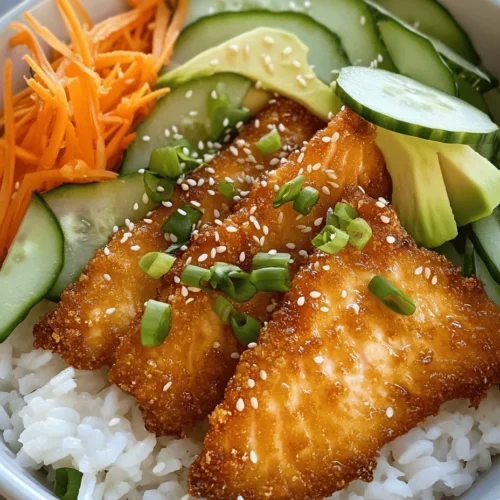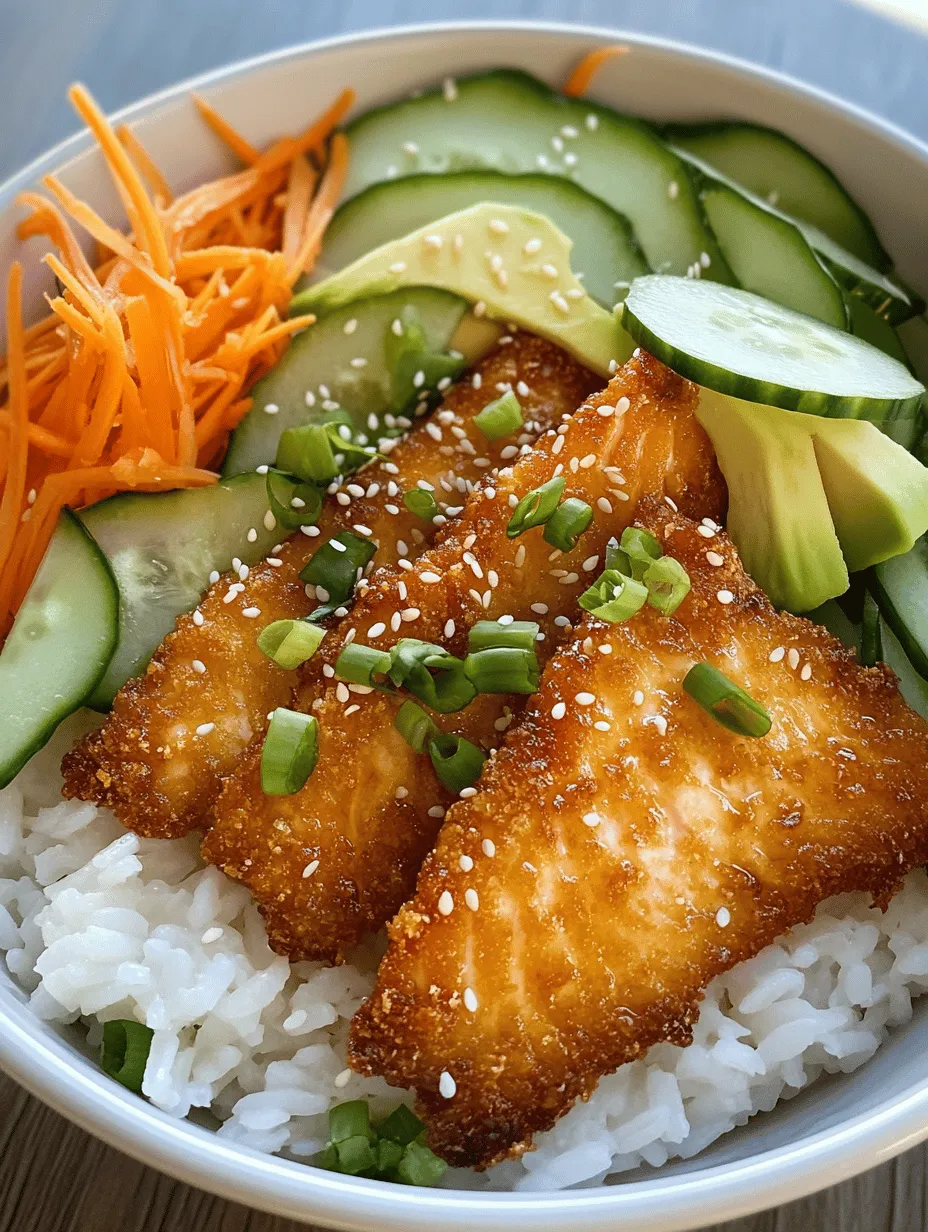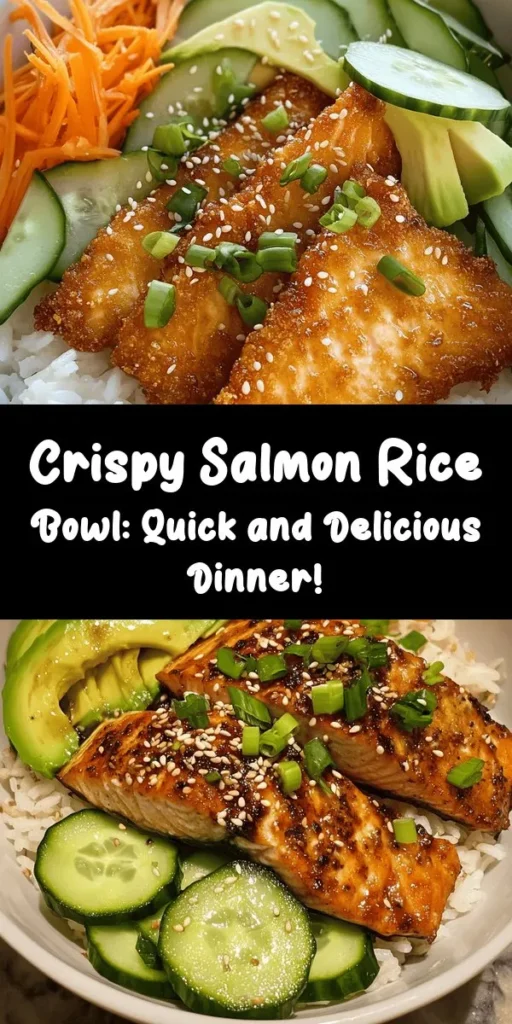In the world of quick and nutritious meals, the Crispy Salmon and Rice Bowl stands out as a delightful blend of flavors and textures. This dish not only appeals to the taste buds but also provides a well-rounded meal packed with healthy fats, vitamins, and minerals. Salmon, a popular choice among health-conscious eaters, brings not just flavor but also significant nutritional benefits. Whether you’re a busy professional looking for a simple dinner solution or a home chef eager to impress guests, this recipe is sure to satisfy. Join us as we explore the ingredients, preparation methods, and nutritional benefits of this delicious bowl.
Understanding the Ingredients
Exploring Salmon: Health Benefits and Nutritional Profile
Salmon is often heralded as a superfood, and for good reason. This fish is rich in high-quality protein, essential vitamins, and beneficial omega-3 fatty acids. Omega-3s are known for their numerous health benefits, including promoting heart health, reducing inflammation, and supporting brain function. Just a single serving of salmon can provide more than the recommended daily intake of these essential fats, making it a perfect addition to a balanced diet.
When selecting salmon for this recipe, opting for skin-on fillets is highly recommended. The skin not only helps to retain moisture during cooking but also adds a delightful crispiness when cooked properly. Moreover, the skin contains valuable nutrients and healthy fats, enhancing the overall nutritional profile of your meal.
The Role of Jasmine Rice in the Dish
Jasmine rice, a long-grain variety known for its fragrant aroma and slightly sticky texture, plays a crucial role in this bowl. Its delicate floral notes perfectly complement the richness of the salmon and the freshness of the vegetables. Beyond its flavor, jasmine rice is a great source of carbohydrates, providing the energy needed for a busy day.
For those looking to make a healthier choice, opting for whole grain jasmine rice can elevate the nutritional value of this dish. Whole grains retain their bran and germ, making them rich in fiber, vitamins, and minerals. This not only aids in digestion but also helps maintain steady blood sugar levels, making your meal more satisfying.
A Closer Look at Fresh Vegetables
No bowl is complete without fresh vegetables, and this recipe features a vibrant array that includes avocado, cucumber, and carrots. Each of these ingredients brings unique flavors and textures while also contributing to the dish’s nutritional benefits.
– Avocado: Rich in healthy monounsaturated fats, avocados are also packed with vitamins K, E, and C, as well as potassium. Their creamy texture adds a luxurious mouthfeel to the bowl while promoting heart health and providing a source of energy.
– Cucumber: With its high water content, cucumber adds a refreshing crunch to the dish. It is low in calories and rich in vitamins and minerals, making it an excellent choice for hydration and overall health.
– Carrots: Carrots are an excellent source of beta-carotene, fiber, and antioxidants. Their natural sweetness and crunch enhance the bowl’s flavor profile while providing essential nutrients that support eye health and immune function.
Incorporating fresh produce not only elevates the taste but also boosts the overall nutritional value of your meal, ensuring you receive a variety of vitamins and minerals in every bite.
Essential Condiments and Seasonings
The flavor of the Crispy Salmon and Rice Bowl is further enhanced by a few key condiments and seasonings. Each ingredient plays a vital role in creating a harmonious balance of flavors.
– Soy Sauce: This umami-rich condiment is essential for giving the salmon its savory depth. It pairs beautifully with the natural flavors of the fish, enhancing the overall taste of the dish.
– Honey: A touch of honey adds a subtle sweetness that balances the saltiness of the soy sauce. When combined, these two ingredients create a delectable glaze that caramelizes beautifully when the salmon is cooked, adding a golden hue to the dish.
– Sesame Oil: Known for its rich, nutty flavor, sesame oil is a quintessential ingredient in Asian cuisine. Just a drizzle can elevate the dish, adding depth and complexity to the overall flavor profile.
For those who enjoy a bit of heat, optional additions like chili flakes or sriracha can be incorporated to bring a spicy kick to the bowl. These ingredients can be adjusted according to your taste preferences, making this recipe versatile for all palates.
Step-by-Step Preparation of the Crispy Salmon and Rice Bowl
Cooking the Rice: Achieving the Perfect Texture
The foundation of any great rice bowl is perfectly cooked rice. For the Crispy Salmon and Rice Bowl, jasmine rice is the ideal choice due to its fragrant aroma and delightful texture. Here are the steps to ensure your rice turns out fluffy and flavorful:
1. Rinse the Rice: Begin by rinsing the jasmine rice under cold water. This step is crucial as it removes excess starch, which can cause the rice to become gummy. Rinse until the water runs clear, indicating that most of the starch has been washed away.
2. Cook the Rice: In a medium saucepan, combine one cup of rinsed jasmine rice with one and a half cups of water. For added flavor, consider using vegetable or chicken broth instead of water. Bring the mixture to a boil over medium-high heat.
3. Simmer and Steam: Once boiling, reduce the heat to low, cover the saucepan with a tight-fitting lid, and let it simmer for about 15-20 minutes. Avoid lifting the lid during this time, as it traps steam that is essential for properly cooking the rice.
4. Fluff the Rice: After the cooking time is complete, remove the saucepan from heat and let it sit, covered, for an additional 5 minutes. This allows the rice to finish steaming. Finally, uncover the rice and fluff it gently with a fork to separate the grains before serving.
Achieving the perfect texture in your rice is an essential step to ensure your Crispy Salmon and Rice Bowl is a success. The fluffy, aromatic jasmine rice will serve as the perfect base for the other ingredients.
Preparing the Salmon: Techniques for Crispy Skin
Now that the rice is cooking, it’s time to focus on the star of the dish: the salmon. A perfectly crispy salmon fillet can elevate your bowl into a gourmet experience. Here’s how to achieve that coveted crispy skin:
1. Dry the Salmon: Start with skin-on salmon fillets. Pat the skin dry with paper towels to remove excess moisture, which is key to achieving a crispy texture. Moisture is the enemy of crispiness, so take this step seriously.
2. Season the Fillets: Generously season the salmon fillets with salt and pepper. This not only enhances the flavor but also helps to draw out moisture from the skin, promoting crispiness during cooking.
3. Prepare the Soy Sauce Mixture: In a small bowl, combine soy sauce with a drizzle of honey. This mixture will act as a glaze and enhance the flavor of the salmon. The sweetness from the honey will caramelize and create a beautiful golden-brown crust on the skin.
4. Cook the Salmon: Heat a non-stick skillet over medium-high heat and add a splash of oil. Once hot, carefully place the salmon fillets skin-side down in the skillet. Allow them to cook undisturbed for about 5-7 minutes. This method allows the skin to crisp up beautifully.
5. Flip and Finish: Once the skin is crispy and golden, gently flip the fillets over. Brush the top side with the soy sauce mixture and continue cooking for an additional 3-4 minutes, or until the salmon is cooked through and flakes easily with a fork.
Creating the perfect crispy salmon requires patience and attention to detail, but the result is worth it. The crispy skin, combined with the tender, flavorful flesh, will make your Crispy Salmon and Rice Bowl a standout dish.
This is just the beginning of the delicious journey into making the Crispy Salmon and Rice Bowl. Stay tuned for the next part, where we will explore how to assemble your bowl and add the finishing touches that will make this meal a culinary delight!

Essential Tips for Using a Non-Stick Skillet
When preparing the crispy salmon for your rice bowl, using a non-stick skillet can make all the difference. Here are some essential tips to ensure your cooking experience is seamless and that your salmon turns out perfectly crispy.
1. Preheat the Skillet: Always preheat your non-stick skillet over medium heat before adding any oil. This ensures an even cooking surface and helps prevent the salmon from sticking.
2. Use the Right Oil: Select an oil with a high smoke point, such as canola, avocado, or grapeseed oil. These oils can withstand higher temperatures without burning, which is essential for getting that golden crust on your salmon.
3. Don’t Overcrowd the Pan: If you’re cooking multiple pieces of salmon, avoid overcrowding the skillet. Cook them in batches if necessary. Overcrowding can lower the pan’s temperature, leading to steaming rather than searing.
4. Use a Spatula Wisely: When flipping the salmon, use a thin spatula to gently lift it from the skillet. This helps maintain the crispy texture while avoiding tearing the fish.
5. Let It Rest: After cooking, allow the salmon to rest for a few minutes. This resting period helps the juices redistribute, resulting in a moist, flavorful piece of fish.
Visual Cues for Knowing When the Salmon is Done
Cooking salmon to perfection requires more than just following a timer. Here are visual cues to help you determine when your salmon is done:
– Color Change: Raw salmon is bright pink and translucent. As it cooks, it will turn opaque and lighter in color. Look for a rich orange hue, indicating that it’s cooked through.
– Flakiness: Use a fork to gently press on the thickest part of the salmon. If it flakes easily and separates into sections, it’s ready to be removed from the heat.
– Internal Temperature: For those who prefer precision, using a meat thermometer can be beneficial. The USDA recommends salmon be cooked to an internal temperature of 145°F (63°C).
Assembling the Bowl: Aesthetic and Flavor Considerations
Once your salmon is perfectly cooked, it’s time to assemble your crispy salmon and rice bowl. This step allows you to showcase your culinary creation beautifully while ensuring every bite is as flavorful as possible.
Suggestions for Arranging Ingredients for Visual Appeal
– Layering: Begin with a base of rice in your bowl. You can use a scoop or mold for a neat presentation. Next, place the salmon fillet on top, slightly off-center.
– Color Contrast: Add colorful vegetables around the salmon. Bright greens like bok choy or shredded carrots, along with vibrant red radishes or cherry tomatoes, not only enhance the dish’s visual appeal but also its nutritional value.
– Garnishing: Finish the bowl by sprinkling sesame seeds or chopped green onions on top. A drizzle of soy sauce or a spicy mayo can add a glossy finish and a touch of flavor.
Balancing Flavors and Textures in the Bowl
To create a well-balanced crispy salmon and rice bowl, consider the following:
– Flavor Profiles: Aim for a mix of savory, sweet, and umami flavors. The richness of the salmon pairs beautifully with the earthy taste of rice and the crunch of fresh vegetables.
– Textures: Incorporate a variety of textures. The crispy salmon contrasts with the fluffy rice and crunchy vegetables, making each bite exciting. Adding a creamy element, such as avocado or a yogurt-based sauce, can also elevate the dish’s texture.
Nutritional Insights and Benefits of the Crispy Salmon and Rice Bowl
A well-prepared crispy salmon and rice bowl is not only delicious but also offers a range of nutritional benefits. Let’s explore the composition of this meal and why it’s a smart choice for your diet.
Analyzing the Nutritional Composition
– Caloric Breakdown: A typical serving of a crispy salmon and rice bowl (including salmon, rice, and vegetables) has approximately 600-700 calories, depending on the portion sizes and additional ingredients used.
– Macronutrients: This dish is rich in protein, with salmon providing about 22-25 grams per 3-ounce serving. The rice contributes around 40-45 grams of carbohydrates, while the healthy fats from salmon and any added oils will generally be around 15-20 grams.
– Vitamins and Minerals: Salmon is an excellent source of B vitamins, particularly B12 and B6, which are essential for energy metabolism. The vegetables add a range of vitamins such as vitamin C, vitamin A, and folate, along with minerals like potassium and magnesium.
Health Benefits of Omega-3 Fatty Acids
One of the standout features of salmon is its high content of omega-3 fatty acids, which offer numerous health benefits:
– Cardiovascular Health: Omega-3s are known to reduce inflammation, lower blood pressure, and decrease triglycerides. Regular consumption of fatty fish like salmon has been linked to a lower risk of heart disease.
– Cognitive Function: Emerging research suggests that omega-3 fatty acids may support cognitive health by improving memory and mood. They are also associated with a reduced risk of neurodegenerative diseases.
The Role of Fiber in the Meal
Fiber is an essential component of a healthy diet, and your crispy salmon and rice bowl provides a good source:
– Importance of Fiber: The rice, especially if you opt for brown rice, and the vegetables contribute significant dietary fiber. This fiber is crucial for maintaining a healthy digestive system and preventing constipation.
– Digestive Health: Including fiber-rich foods in your meals can help regulate blood sugar levels, lower cholesterol, and promote a feeling of fullness, making it easier to maintain a healthy weight.
Serving Suggestions and Variations
The beauty of the crispy salmon and rice bowl lies in its versatility. Here are some suggestions for adapting the recipe to suit different dietary preferences and flavor profiles.
Adapting the Recipe for Different Diets
– Gluten-Free Options: If you’re looking to keep the meal gluten-free, ensure your soy sauce is labeled gluten-free or consider using coconut aminos as a substitute.
– Low-Carb Alternatives: For a low-carb version, replace the rice with cauliflower rice for a lighter option that still provides a satisfying texture and flavor.
– Vegetarian Adaptations: For a vegetarian twist, replace the salmon with tofu or tempeh. Marinate and pan-sear these alternatives to achieve a similar crispy texture and flavor profile.
Exploring Flavor Variations
– Additional Toppings: Experiment with different toppings such as pickled ginger, wasabi, or a drizzle of teriyaki sauce for added depth of flavor.
– Incorporating Seasonal Vegetables: Adapt the bowl to the seasons by including fresh, seasonal vegetables. In summer, consider adding zucchini or corn, while autumn might call for roasted squash or Brussels sprouts.
Conclusion
The crispy salmon and rice bowl is more than just a meal; it’s a celebration of fresh ingredients and balanced nutrition. With its ease of preparation and customizable nature, this dish is perfect for a weeknight dinner or a special occasion. By understanding the ingredients, mastering the cooking techniques, and recognizing the nutritional benefits, you can create a delicious and satisfying meal that nourishes both body and soul. Enjoy this culinary journey and relish every bite of your homemade bowl!



